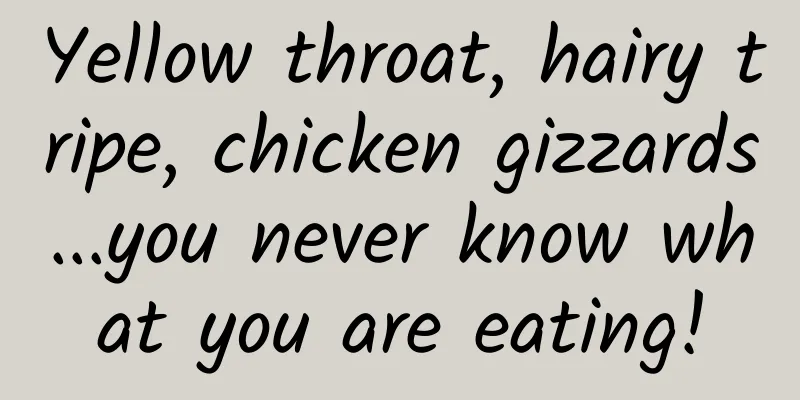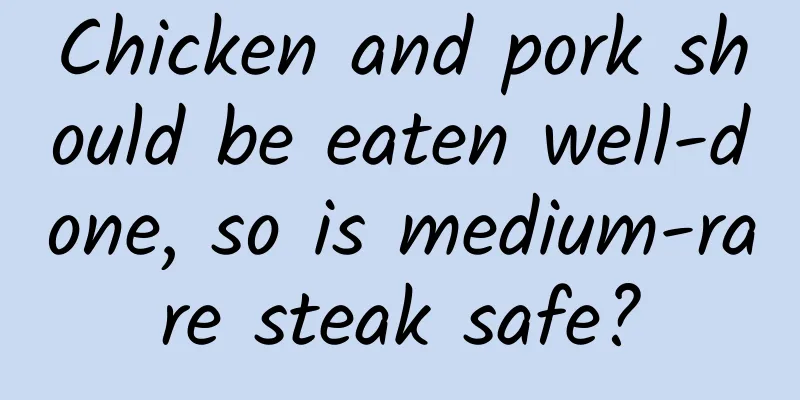Yellow throat, hairy tripe, chicken gizzards...you never know what you are eating!

|
Who would refuse a hot pot invitation? From the internal organs to the skin of an animal, everything can be boiled in the same pot of boiling water and oil, bringing people a rich and diverse taste experience. Tripe, throat, kidney, gizzard, pig intestines ... these ingredients made from animal offal are easy for everyone to eat. Whether it's up and down, or just changing color, or patiently waiting for it to roll over and float, everyone knows how to eat it. But is the yellow throat really the throat? Is the tripe really the stomach? Is the pig intestine used to produce 💩? My colleagues and I went to a hotpot restaurant and had a delicious meal. All the ingredients mentioned above were used, and in addition, the plates of fat beef top and beef tongue were so delicious that they made my heart ache. Boiled beef|TuChong Creative While wiping their mouths, everyone talked about the source of the delicious beef - yellow cattle (Bos taurus) . Chinese people seem to have a deep-seated preference for cattle. Although not as deified as the humped cattle in India, the image of cattle in Chinese culture is always positive, and words such as hardworking, persevering, and friendly are used by us generously to describe this livestock. Chinese people have been using and domesticating cattle for a long time. In the southern rice-growing areas, we have common water buffaloes; in the plateau, we have domesticated yaks; and in addition, we are more familiar with China's unique domestic cattle breed, the Chinese yellow cattle . Scalper (not the one at the theater entrance)|wikimedia Confusing origins Although today we regard yellow cattle as an integral part of the domestic cattle family, the origin of this unique Chinese cattle breed remains confusing. Existing archaeological evidence indicates that the domestication of cattle began in West Asia and Northeast Africa 10,000 years ago. At that time, humans had entered an agricultural society, and sufficient food supply supported a larger population. The gradually developing agricultural needs also urgently required a powerful draft animal . The aurochs, which were widely distributed in the Eurasian continent, were then domesticated and eventually became today's domestic cattle. Like many foreign livestock and poultry in history, domestic cattle may have entered Eastern civilization along the route of West Asia-Kazakhstan-Northwest China-Central Plains. The wild species of domestic cattle - the European aurochs, the first domestic cattle domesticated by West Asian civilization, is its descendant|wikimedia But the irony is that many domesticated organisms have been spread along this route in the past, and the temporal and spatial connections of the spread of these species are also shown along this route. But for domestic cattle, there is almost no trace of them on the way from West Asia to China. From the domestication of cattle by ancient West Asian civilization 10,000 years ago to the appearance of traces of domestic cattle in the Qijia culture sites in Gansu and Qinghai and the Longshan culture sites in the Central Plains 4,500 years ago, domestic cattle seemed to have suddenly appeared on the stage of Eastern civilization. Domestic cattle in Israel today | Zachi Eveno / wikimedia What is even more puzzling is that in the ancient ruins of Yinsuo Island in Erhai Lake, Yunnan, even the skeletons of domestic cattle dating back 5,000 years ago were unearthed. It only takes simple logical reasoning to imagine that if domestic cattle spread from West Asia to the Central Plains, then this tribe far away in southern Xinjiang should have come into contact with domestic cattle later than the Central Plains culture. By directly comparing Chinese cattle with other domestic cattle populations around the world, we can also find some very significant differences: Chinese cattle generally have short horns, and there are even many hornless individuals ; Chinese cattle have poor lactation ability , so we have not evolved eating habits related to milk in history; and congenital defects such as hairlessness, single hoof, and double muscle layer that often appear in other domestic cattle populations are basically extinct in Chinese cattle. This is the confusion over the origin of Chinese scalpers. The appearance of domestic cattle can vary greatly. Swipe left and right to view, in order: yellow cattle, British longhorn cattle, Holstein cows, and African cattle. | Dave & Keith Weller / wikimedia; Richard Du Toit / mindenpictures Maybe it's hybridization. Some scholars believe that, like pigs and chickens, the domestication of cattle may have multiple independent origins . In the early days of the founding of the People's Republic of China, a red copper pot from the Yan State of the Warring States Period was unearthed in Tangshan. The hunting pattern depicted on it clearly shows a short-horned variant of the aurochs that was once widely distributed in Asia. The remains of domesticated cattle unearthed in China have shown relatively mature evidence of domestication , which seems to indicate that the domestication of cattle was not completed in China. But is it possible that some civilizations closer to China also obtained domesticated cattle by domesticating this short-horned aurochs variant, and then spread them to the Chinese cultural circle? A rubbing of a hunting pattern on a red copper pot from the Yan State during the Warring States Period, with a short-horned bison in the center. Some scholars also believe that the origin of Chinese yellow cattle is more likely the result of hybridization of multiple domesticated species. The humped cattle that are domesticated in large numbers in India today were also widely distributed in my country during the pre-Qin period. In the oracle bone inscriptions of Yinxu, there are a lot of descriptions of "white cattle", and the genetic characteristics of white can basically be judged as a genetic mutation of humped cattle, which is also direct evidence that humped cattle were once domesticated in the Yellow River Basin. Of course, with the later climate changes, the rhinos, elephants and humped cattle in the Central Plains gradually declined, but it is very likely that domestic humped cattle have hybridized with domestic cattle, eventually producing the distinctive Chinese yellow cattle - today, the southern breed of Chinese yellow cattle still retains the unique shoulder hump characteristics of humped cattle. The shoulder hump of a zebu | Scott Bauer / wikimedia Eating beef has been a tradition since ancient times. Although the origin of the yellow cattle is still unclear, its importance to the Central Plains civilization is unquestionable. Like many domesticated animals, cattle were originally domesticated for meat. For a long time before the Western Zhou Dynasty, cattle were mainly used for meat. In the pre-Shang Dynasty Zhuangdeng cultural site, the proportion of cattle bones was still at a low level of 16.9%; but in the Huanbei Shang City site in the middle Shang Dynasty, it climbed to 35.78%; in the late Yinxu site, the proportion of cattle bones even exceeded 40%. Since the meat yield of a cattle is three times that of a domestic pig, it can be concluded that beef had become the most consumed meat in the middle and late Shang Dynasty. Beef, how do you like it? | Jon Sullivan / wikimedia We often say that to judge whether ordinary people have a good life, we should first look at their food basket. Unlike domesticated pigs and chickens, cattle have a long breeding cycle and a very low feed-to-meat ratio. However, in the pre-Qin period, people's meat choices could reach such a "luxurious" height, which shows the prosperity of the Shang Dynasty. In addition to being eaten, the diversity of cattle's functions before the Western Zhou Dynasty is also astonishing. At that time, cattle were regarded as important "benevolent animals" and were often used in sacrificial activities before the start of important projects. In contrast, domestic animals such as pigs and dogs tend to be more courageous, so they are often used as burial objects. Before the spread of domestic horses to China, cattle were also important riding and camel-carrying animals . In some areas, cattle are still used as pack animals | Juan Cristóbal Hurtado / behance.net Killing a cow is a great act of treason. However, since the Western Zhou Dynasty's "Ceremony" recorded that "princes should not kill cattle without reason", until September 1984, when people were allowed to slaughter and sell cattle, the edible value of cattle was strictly restricted. Why is this? "Tang Law Commentary" gives the clearest answer: "Official and private horses and cattle are important for their use: cattle are the basis of farming, and horses are used to support the army." In order to ensure that there are enough working animals for agricultural production, the system of protecting working cattle, which prohibits private killing of cattle, has been included in the legal system of successive dynasties. This system of protecting working cattle, which has lasted for more than 2,000 years, also has different measurement criteria. The protection of oxen was the most stringent during the Tang, Song, and Five Dynasties. No matter how old or small the oxen were, they were not allowed to be slaughtered. They could only be eaten after they died naturally. In comparison, the Han, Ming, and Qing governments believed that young oxen were most useful, and once they were old, they could still be sold on the market for consumption with the permission of the government. Of course, whether an ox was old or not was not decided by the owner of the ox . In the work of the grassroots government at that time, judging whether an ox was old was probably an important part of the work. Newly born calf | wikimedia If someone privately killed a working ox, or even killed someone else's working ox, he would be punished by iron law: in the Ming and Qing dynasties, if you privately killed your own working ox, you would be caned 100 times; if you killed someone else's working ox, you would be exiled 3,000 miles away. In comparison, the Han Dynasty's system treated everyone equally - as long as you killed a cow, whether it was your own or someone else's, you would be dead. For nearly 100 years after the feudal dynasty was overthrown, China's cattle were still protected by such policies. From the Republic of China to the post-liberation period, cattle were still an important force in agricultural production for a long time. It was not until the 1980s, when agricultural machinery became increasingly popular and in order to encourage the development of the beef cattle industry, that this cattle protection system finally became history. The image of an old ox plowing the land is a microcosm of my country's traditional agriculture|xuehua.us Looking back at how we emerged from East Africa, spread across the globe, and have achieved such great success today, our identity has undergone multiple transformations in the course of history, and the creatures that have accompanied us have also played different roles over the years. The story between the Chinese and the cattle is a vivid example of this. From its confusing origins, to the cycle of meat-for-labor, to the long-standing laws and regulations, the importance of the cattle in the past is unquestionable. And in the future, this perseverant and gentle animal will continue to accompany us. Author: A man is wandering This article comes from the Species Calendar, welcome to forward If you need to reprint, please contact [email protected] |
<<: Can eating rice like this help you lose weight? Are you tempted?
Recommend
Things you need to know about Android push notifications
Some time ago, the "Unified Push Service All...
Teach you how to write hit copy with zero basic knowledge! (Down)
Part 2: Five common attributes of popular copywri...
The master cracked the Trojan APP and burst into laughter at the end
Everyone knows that you should not click on the l...
Tesla factory is coming! The Chinese factory site is expected to be announced this year
The development momentum of new energy vehicles i...
Be careful! Feeling sleepy all the time may be a sign of illness
Expert of this article: Guo Xiangping, Deputy Sec...
Three major subsystems behind the large-scale user operation system
Previously, we already had a very deep understand...
What is carrageenan and what role does it play in ice cream?
Recently, "ice cream assassin" has beco...
How to deal with ophthalmic emergencies?
Acute attack of primary acute angle-closure glauc...
SMMT: Tesla's sales in February 2025 increased by 20.7% year-on-year, and its market share increased by 4.6%
Tesla's sales in the UK rose by more than a f...
Practical course on sharing good things on Douyin, no need to shoot, simple editing, short videos can quickly increase followers (125 video courses)
Douyin good things sharing practical course, no n...
With a R&D team of thousands of people, why is NIO’s intelligent driving progress two steps behind the industry?
Sometimes, what is more regrettable than having n...
Advanced Operations: How to use 4P theory to achieve growth?
As we all know, operations are divided into produ...
2018 Tik Tok Research Report! (Full version)
“5 minutes on TikTok is like 1 hour in the real w...
Strip off the German mask of Kambach wok, and Chinese-made products should embrace national confidence as soon as possible
From Playboy and Ports clothing in the past to De...
With R&D funding only half of its competitors, how much advantage can Ecovacs maintain after sliding from the blue ocean to the red ocean?
Since July, Ecovacs' stock price has been fal...

![[APP Promotion] How to promote and operate a new App?](/upload/images/67cc450d3c6c1.webp)







